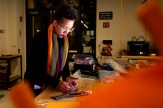Researcher’s sustainable fertilizer breakthrough fueled by machine learning and quantum mechanics

A computational lab on Northeastern University’s Boston campus may seem like an unlikely place for major advances in agriculture.
But that’s exactly the place where Qing Zhao, an assistant professor of chemical engineering, is studying more efficient and sustainable ways to produce a key ingredient in fertilizers.
Zhao leads a group of researchers focused on computational catalyst design. This uses quantum mechanics — science that analyzes the behavior of molecules and atoms and their constituents: electrons, protons, neutrons, quarks, etc. — and machine learning to understand chemical reactions and design more energy-efficient and reactive catalysts.
“It helps us in understanding the most fundamental chemistry in materials and reactions,” Zhao says.
The group is working on projects that range from converting carbon dioxide into fuels to hydrocarbon fuels to recycling plastic wastes into useful chemicals. It also works to develop new computational modeling tools to understand different aspects of chemistry.
“There are abundant (atmospheric) molecules in the world,” Zhao says. “We want to make good use of them by converting them into useful chemicals.”
Ammonia — one of the most manufactured chemicals in the world and widely used in fertilizers — is one of those useful chemicals.
But industrial manufacturing of ammonia requires very high temperatures and pressure to convert its nitrogen gas and hydrogen gas.
“Which means that we need to burn unsustainable fossil fuels to generate such high temperature and pressure,” Zhao says. “So it generates a huge amount of carbon dioxide and consumes massive unsustainable energy resources to meet the high demands of ammonia.”
There’s another way to produce ammonia that is more environmentally friendly.
But this method — which uses sustainable resources such as solar and wind energy to drive the reaction between nitrogen gas and water at ambient temperatures — is not energy efficient enough to meet the goal set by the Department of Energy for commercialization, Zhao says.
Editor’s Picks
“To improve the energy efficiency, we want to have a better understanding of the fundamental chemistry in the reaction,” Zhao says. “In that way we can design a better device — or electrochemical cell — where this reaction takes place.”
So, Zhao is looking at a specific chemical process of using lithium-based electrolytes as opposed to aqueous electrolytes to catalyze the reaction — a lithium-mediated nitrogen reduction reaction.
That’s where the computer lab comes in.
Zhao says that because the reaction happens so fast and is at the atomic scale, many important chemical aspects cannot be captured by experimental tools such as microscopes and spectroscopes.
So she and her students are applying advanced computational models and machine learning to understand the reaction and chemistry. The work has earned Zhao a National Science Foundation CAREER Award, which supports early-career faculty who have potential as leaders and academic role models in research and education.
Zhao hopes that this work could lead to lessening the reliance on fossil fuels to produce ammonia and thereby benefit the environment.
“I hope that I can work with my students to make contributions to sustainable chemical production and theory development to understand complex chemical reactions along the way,” Zhao says.











